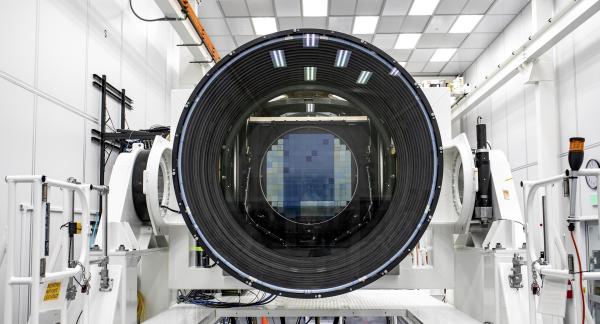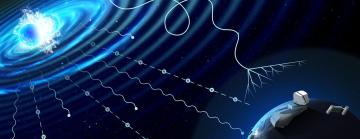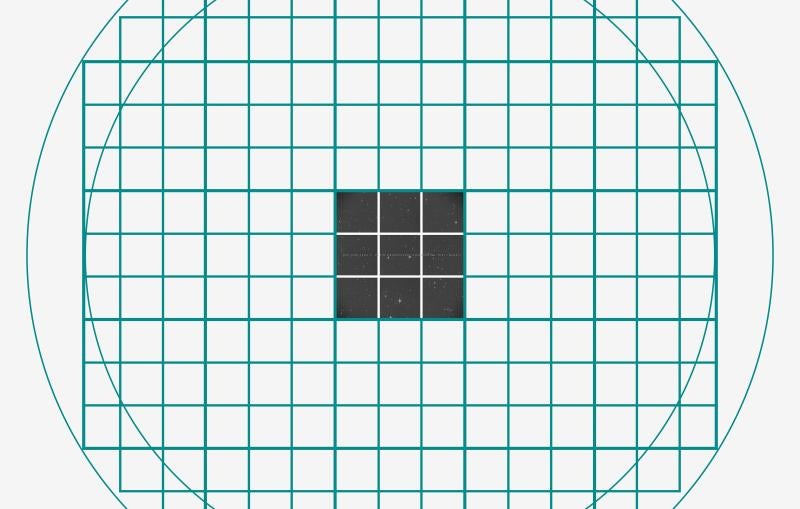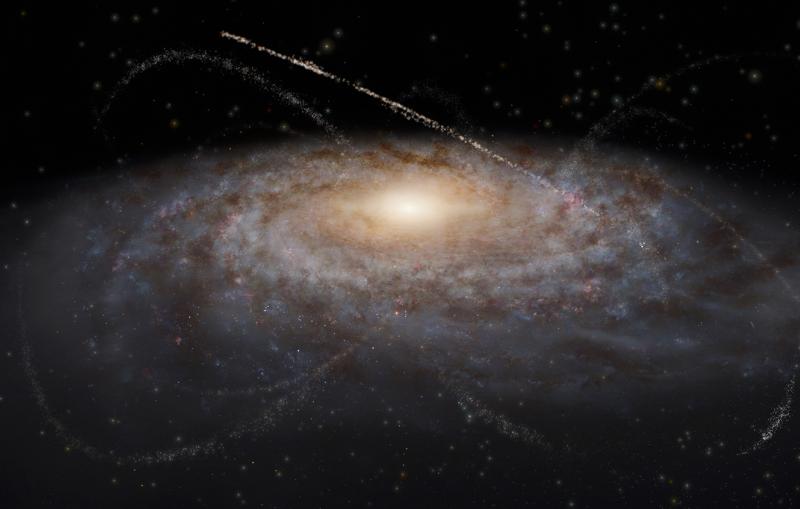NSF–DOE Rubin Observatory’s unparalleled vision will revolutionize multi-messenger astronomy
Vera C. Rubin Observatory will unite coordinated observations of cosmic phenomena using the four messengers of the universe.
LSST Camera
Vera C. Rubin Observatory will search wide and deep into the cosmos for signs of dark matter and dark energy and yield new insights into our own galaxy and solar system. SLAC built Rubin's LSST Camera (above), the largest camera ever built for astrophysics. SLAC will also host Rubin's U.S. Data Facility and co-lead the observatory's operations along with NSF's NOIRLab. (Image Credit: Jacqueline Ramseyer Orrell/SLAC National Accelerator Laboratory)

Photons, neutrinos, cosmic rays and gravitational waves all carry information about the universe. Multi-messenger astronomy brings together these four signals to investigate astronomical events from multiple cosmic perspectives. With its sensitive camera and suite of filters, NSF–DOE Vera C. Rubin Observatory will increase the population of known multi-messenger sources by obtaining crucial color information and localizing events for follow-up observations by other telescopes.
Astronomy has always relied on light to convey information about the universe. But capturing photons is no longer the only technique scientists have for studying astronomical phenomena. Subatomic particles, such as neutrinos and those that are delivered in the form of cosmic rays, as well as gravitational waves – ripples in the fabric of space-time – are also messengers. Multi-messenger astronomy aims to combine the information from more than one of these signals to give researchers a deeper understanding of some of the most extreme events in the universe. NSF–DOE Vera C. Rubin Observatory will soon contribute to this emerging field by using its powerful camera and wide field of view to find faint multi-messenger sources and point other telescopes in the right direction for follow-up observations.
Multi-messenger astronomy is an enhanced way of studying cosmic events that are predicted to emit more than one type of signal, such as stellar explosions, actively feeding black holes, and collisions between compact objects, to name just a few. Each messenger communicates unique information about the physical processes and energies involved. When a single source is observed using multiple signals the data can be combined to reach a deeper level of insight. “The result is more than the sum of its parts,” says Raffaella Margutti, associate professor at the University of California at Berkeley.
In addition to conducting a massive study of the southern sky called the Legacy Survey of Space and Time (LSST), Rubin will also perform “target of opportunity” observations in quick response to alerts of potential multi-messenger sources. As the fastest-slewing large telescope in the world, Rubin can point to targets in as little as three minutes. Such observations will provide crucial information about an event’s optical – meaning wavelengths detectable by the human eye – properties, which in turn helps localize the event for follow-up by other telescopes.
However, in order to coordinate multiple telescopes capable of detecting the different types of messengers, scientists have to know where to look. Signals such as gravitational waves and neutrinos can point scientists in the general direction of a source, but in order to pinpoint its exact location you need light. This is where Rubin, equipped with the largest camera ever built for astronomy and astrophysics, will shine.
Margutti, whose studies focus specifically on finding the electromagnetic counterparts to gravitational wave events, explains, “Gravitational wave observatories can only tell you ‘look at this large area and search for something very faint.’ But you don't know exactly where to look.” Furthermore, the distance at which current observatories are capable of detecting gravitational waves can be far beyond the limit of what they can detect with photons, making it hard to observe an event with both messengers.
With its deep and wide capabilities, Rubin will help mitigate both of these challenges. “Rubin wins twice,” says Margutti. “Its strong light-collecting power and ability to scan large sections of sky mean it’s very sensitive to faint optical signals, like those we would be seeking from a gravitational wave source.”
So far only one multi-messenger gravitational wave event has been observed: a merger between two neutron stars that sent both space-time ripples and photons careening across the cosmos. Other events predicted to emit more than one messenger are black hole-neutron star and black hole-black hole mergers. “I would be super excited if we found photons coming from these types of mergers,” says Margutti. “Rubin is uniquely positioned to confirm or expand on the types of mergers that produce light.”
Rubin’s ability to detect faint sources will also be a game changer for studying neutrinos. Robert Stein, California Institute of Technology postdoctoral scholar, explains: “In neutrino science there are many different types of possible sources, but existing optical telescopes are only able to see the brightest, most unusual ones.” Based on the number of neutrinos arriving at detectors here on Earth, scientists believe there to be a vast population of neutrino sources at varying distances throughout the universe. However, given the limits of existing telescopes, Stein estimates that only 5–10% of them are also detectable with photons. By bringing myriad faint sources to light for the very first time, Rubin could increase that to 50%.
“Neutrino science is in its infancy, so our list of possible sources is still emerging,” says Stein. “In ten or fifteen years we will likely discover that events we’ve already known about are also neutrino source populations.”
Margutti and Stein are both confident that the overarching power of Rubin in the era of multi-messenger astronomy will be in uncovering the unexpected. As it covers vast swaths of the southern hemisphere sky, there’s no telling what Rubin’s unparalleled vision is going to reveal. “The best use of Rubin is as a discovery machine,” says Margutti. Stein echoes a similar sentiment, saying, “I hope to learn what new types of sources we should investigate next. If Rubin could give us that clarity, and I believe it will, that would be amazing.”
Rubin Observatory is a joint initiative of the National Science Foundation (NSF) and the Department of Energy (DOE). Rubin is operated jointly by NSF’s NOIRLab and SLAC.
This article is based on a story from the Rubin Observatory.
For questions or comments, contact SLAC Strategic Communications & External Affairs at communications@slac.stanford.edu.
About SLAC
SLAC National Accelerator Laboratory explores how the universe works at the biggest, smallest and fastest scales and invents powerful tools used by researchers around the globe. As world leaders in ultrafast science and bold explorers of the physics of the universe, we forge new ground in understanding our origins and building a healthier and more sustainable future. Our discovery and innovation help develop new materials and chemical processes and open unprecedented views of the cosmos and life’s most delicate machinery. Building on more than 60 years of visionary research, we help shape the future by advancing areas such as quantum technology, scientific computing and the development of next-generation accelerators.
SLAC is operated by Stanford University for the U.S. Department of Energy’s Office of Science. The Office of Science is the single largest supporter of basic research in the physical sciences in the United States and is working to address some of the most pressing challenges of our time.






